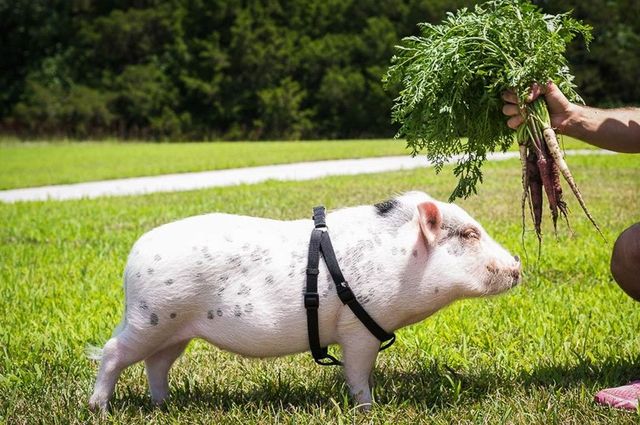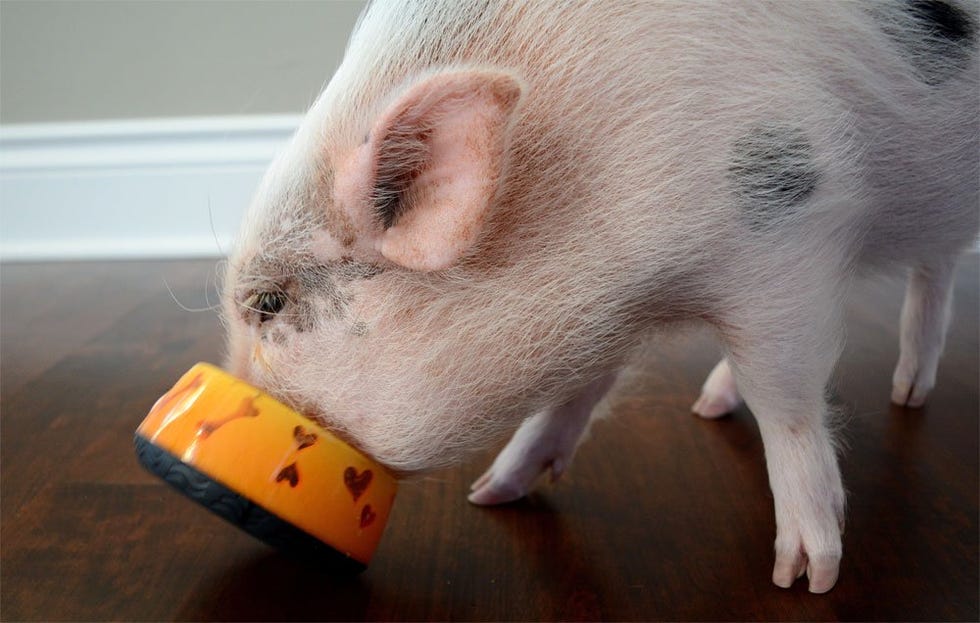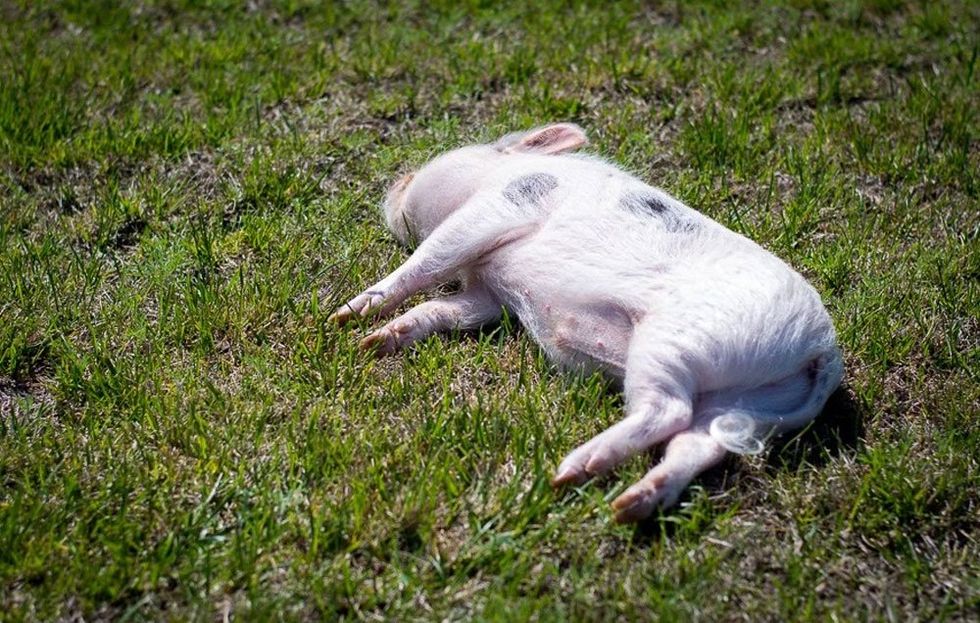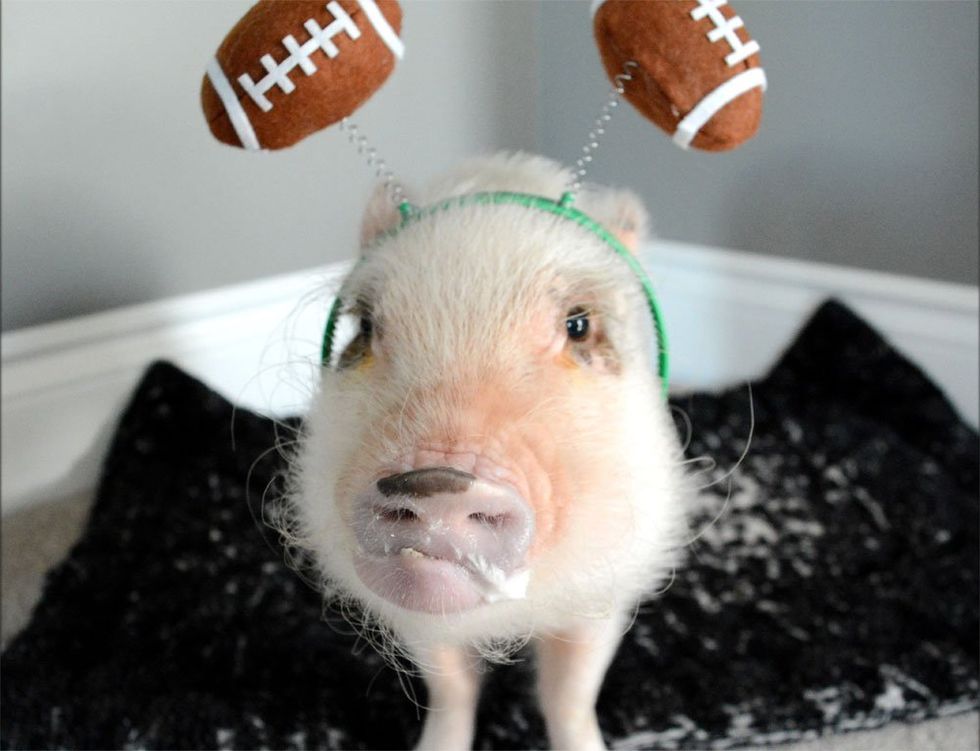Like the tiny dogs in designer purses popular in the '00s, mini pigs are having a bit of a moment. But contrary to what you might think when you see one on your Instagram feed — wearing a tutu, snacking on a carrot, or generally looking adorable — pigs aren’t pink pups that oink instead of bark.
Pigs come with their own unique set of needs, behaviors, and quirks, which, for many new enthusiastic owners, comes as a big surprise. "I’d estimate that 90% of mini pigs that are bought or adopted are given up within two years," says Richard Hoyle, director of The Pig Preserve, a pig rescue sanctuary in Jamestown, Tennessee.
That’s sad, and it shouldn’t happen. While there’s no guaranteeing that a new pet will mesh with your family until you bring him home, there are plenty of steps you can take to greatly improve your chances. Here are eight things every wannabe owner should know about making sure the pig you adopt into your family stays a part of family — for life.
1. Your mini pig won’t stay mini forever.
Mini, micro, teacup, pixie: There are lots of different names that breeders use to describe their pigs. Problem is, none of them are regulated — so it’s pretty tough to know exactly how big your little pig will get. “There are 15 to 20 breeds of mini pig, and all of them are 150 to 180 pounds at full size,” says Hoyle. (That sounds huge, but compared to full-size farm pigs, which hover around 600 pounds, they are mini.) “A breed of very tiny pigs doesn’t exist in nature," he adds.
And because pigs can take up to five years to reach their full size, it’s tough to tell how large your new pet eventually become. Your best bet is to visit your pig’s parents in person so you can see how big they are, according to American Mini Pig Association. If mom and dad are larger than what you could realistically care for, their piglet probably isn’t the right one for you.
2. A rescue is a much better bet than a breeder.
Mini pigs can live for more than 20 years. But sadly, many owners put them up for adoption after just a year or two once they realize they can't care for them. "There’s no need to spend thousands of dollars at a breeder when shelters and sanctuaries are already begging people to take their pigs," Hoyle says.
There are other benefits to adopting, too. Shelters will only adopt out pigs that are healthy and well-socialized, so you’re less likely to have to deal with huge vet bills or behavior issues. Plus, since the pigs tend to be older, they’re more likely to have reached their full (or nearly full) size.
And because shelters are invested in finding forever homes for their pigs, they’ll take the time to educate you about your new companion’s needs. "They want to see this work out. But if it doesn’t, unlike a breeder, they’ll normally take the pig back," Hoyle says.
3. Your pig might not like you at first.
Have dreams of bringing your little piggy home and snuggling on the couch or playing fetch together? Pigs and their human parents bond eventually — but the process is slow.
"It’s not like bringing a dog home,” says Tamara W., who adopted a mini pig named Oscar in 2015. (That's Oscar in all of these pictures!) When Tamara and her husband Casey first introduced their little pink bundle to their house, Oscar was scared and didn’t want to be touched. "He corralled himself up in the garage, and it was probably two hours before we caught him," Tamara says.
4. They might even try to push you around.
After nearly a year, Oscar has gotten closer to Tamara and Casey. At night, he’ll even cuddle with them on the couch. But because pigs are hierarchical, they can get aggressive — especially if they sense that you aren’t willing to take charge. "Being the pack leader with a pig is important," Tamara says. "So they might head butt, nip, or bite if they think you’re lower on the totem pole."
5. Yep, they really do love food that much.
Pigs live to eat, which can be both good and bad. When Oscar starts to get hungry, he’ll stand by his food bowl and oink loudly until he gets his meal. “If Oscar thinks he’s going to be fed, he’d jump off the side of a bridge," Tamara says. "He can’t think about anything but that food."
On the upside, that laser focus on all things edible means that pigs are easy to train. Tamara started using food to train Oscar when he was just 8-weeks-old, and the possibility of getting delicious treats like Cheerios and freeze-dried peas made him a fast learner. “Now, he’s fine off-leash. But if you’re nervous, you can keep a treat in your pocket,” says Tamara. “If you hold up a piece of food, he’ll run to you.”
6. They need to be able to do their pig thing.
Forget life in a tiny apartment. Access to plenty of outdoor space is non-negotiable for pigs — even mini ones. After breakfast, Tamara takes Oscar outside so he can perform natural behaviors like rooting and grazing. "It’s so important for them to be good and have them not root around on rugs," she says.
Social time is essential, too. "Pigs hate to be alone," Hoyle explains. "They have high social needs, and if they aren’t met, it can cause destructive behavior." Some pigs, like Oscar, seem to be satisfied spending time with their human companions.
But according to Hoyle, most pigs do best when they can also hang out with their own kind. “Pigs enjoy their company with humans — they like belly rubs and treats," he says. "They don’t live to be with humans, though. That’s why most successful pig owners have at least two pigs."
7. They can do some other quirky stuff, too.
As with all animals, pigs have reasons for why they do what they do. But since we can’t read their minds, some of their antics come off as just plain silly. Which, Tamara says, is a big part of the fun. Sometimes, Oscar likes to nibble at his human family members’ toes, or rearrange their shoes. "He also started doing this thing where he’d get sleepy and squeal for an hour while walking around the house," says Tamara. "It’s not annoying — it’s just like, 'What are you doing?' He’s a strange, hilarious creature."
8. Earning their affection is the ultimate reward.
Most dogs will become your BFF in a matter of minutes, but bonding with a pig can takes months. "In the beginning, pigs are stubborn," Tamara says. "They only do what they want to do."
At first, that can be a bummer (why doesn’t my pig love me the way I love him?!). But when your pig finally does come around? It’s that much more gratifying. "They come home so scared, and you go from not being able to touch them to having them come lay next to you. That’s an amazing feeling," Tamara says. "If you’re willing to put in the work, you’ll get that reward."
Editor's note: Since this story was originally published, Oscar has since moved to Hog Haven Farm in Colorado. Tamara made the difficult decision to give up Oscar after his relationship with her family dog, Rylee, deteriorated, but believes Oscar is now happier than ever in his new home.
















